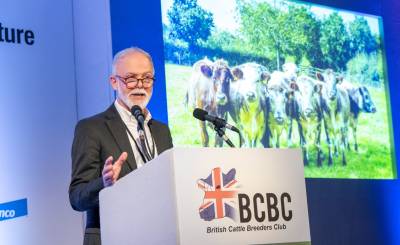
This article was written by Rhian Price, press officer for the British Cattle Breeders Club.
Regenerative farming is fundamental to delivering ecological security, ecological efficiency, and optimal productivity.
We are facing a climate crisis which threatens ecological insecurity, locally and globally.
As we peer into the coming storm policy is driving in two opposite directions:
- There is the industrialised future, where protein is produced in labs and land is divided into hyper-rewilding units. In this world, the cow has been demonised and shuffled into highly industrialised, fully indoor units.
- The agroecological future, where food is produced in partnership with nature. In this future, the grazing cow is the hero.
In this agroecological future –– the regenerative future –– farmers apply the knowledge, data, science, and monitoring technology they have at their fingertips to deliver excellent productivity for both the farmer and nature.
Emissions
We cannot reverse climate change solely by reducing emissions. Instead, we must also address biodiversity loss and soil health.
Our capacity to deliver food security is underpinned by ecological security. This means we must recognise the interface between ecology, food production and national global security.
Climate change is already affecting global food production, with failed harvests in Russia, for example.
The impact of conflicts, such as the expansion of the Gaza war to the Red Sea, where Houthi attacks effectively closed the Suez Canal for weeks in January, show that our reliance on global trade makes us vulnerable.
We must rebuild natural resilience by turning to regenerative farming for ecological security.
Soil health and the role of the cow
Soil health should be a national security priority and the cow is the ecosystem engineer that makes regeneration possible.
Adaptive multi-paddock grazing allows paddocks to be grazed concerted for three to four days and then rested for perhaps three to five months, allowing the ground to rest and recover.
Meanwhile, manure deposited by the cow provides the soil with nutrients, which aid sward regrowth, above and below ground.
The dunging and trampling effects unlock nutrients and other processes in the soil. Improved seed diversity attracts a greater diversity of insects and biodiversity thrives, above and below ground.
Deeper tap roots mean the earth holds water in a soil carbon sponge, acting as a great reservoir below the ground.
Because its biomass is greater, this grassland delivers faster transpiration of water from liquid into gas. During this process, hydroxyl ions are produced which clean and filter pollutants and gases, such as carbon from our atmosphere.
In a regenerative system, more hydroxyl ions are produced than needed to break down biological methane produced by the cows.
The biomass of grass also protects the soil from sunlight. This means the soil remains at a constant temperature of about 20 degrees C, even in a heatwave. In comparison, if the land was bare, temperatures could reach up to 70 degrees C. So, just by keeping the ground covered, the cow is delivering a cooling effect, as less heat is absorbed and retained in the ground.
Soil organic matter grows within this system, capturing carbon from the air and locking it inside the ground.
The cow is the ecosystem engineer that ties all these processes together.
In comparison, fully housed dairy systems, or grain-based feedlots fail to deliver regeneration because cattle are not grazing. Instead, they are inherently reliant on fossil fuels and their feed systems are dependent on monocultures and petrochemicals.
These systems erode soil health and soil carbon, instead of building it.
Methane is the wrong metric
Carbon tunnel vision and a focus on methane reduction have helped justify the expansion of these high-tech systems.
Methane is a short-lived gas, with a half-life of about 10 years. After 20 years, almost all its warming impact have disappeared.
In comparison, the carbon dioxide emissions from burning fossil fuels can last for thousands of years.
Providing cattle numbers do not increase, there is no new warming from that herd – each emission is simply replacing another.
In the UK, cattle numbers have reduced over the past 20 years. This means we are already below net zero warming in terms of cattle methane. We need to repeatedly articulate this to policymakers and the media.
Science is gradually catching up.
GWP100 over-valued the global warming impact of stable, ongoing emissions by short-lived gases such as methane by a factor of 3 to 4.
The revised metric, GWP*, is a more accurate measure of the warming impacts of methane and has been accepted by the Intergovernmental Panel on Climate Change (IPCC).
Profit, not production, is key
Farmers are worried that if they transition to regenerative farming, they will lose output.
The metric that should really matter is profit, not production.
Regenerative farmers have been able to reduce input costs and adapt their genetics to deliver robust, healthy animals, which has improved farm profitability overall.
Breeding is as important to regenerative agriculture as it is to mainstream farming, but regenerative outcomes and values are different.
Instead of low methane cows, rapid growth and high production, regenerative farmers look for resilience, intelligence, good nurturing, and mothering skills. They need stock that is easy to handle, that is robust and healthy, can self-medicate from diverse leys and hedgerows. They need cows that can thrive on rougher forage and in outwintering systems. They require smaller-framed animals that produce lower volume, but higher nutritional quality.
The world’s changing – we need to change, too.
You are well-placed to play a leadership role as this new world emerges.